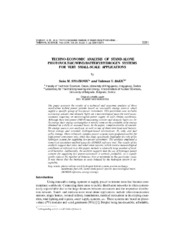Приказ основних података о документу
Techno-Economic Analysis of Stand-Alone Photovoltaic/Wind/Battery/Hydrogen Systems for Very Small-Scale Applications
| dc.creator | Stojković, Saša M. | |
| dc.creator | Bakić, Vukman | |
| dc.date.accessioned | 2018-03-01T17:00:23Z | |
| dc.date.available | 2018-03-01T17:00:23Z | |
| dc.date.issued | 2016 | |
| dc.identifier.issn | 0354-9836 | |
| dc.identifier.issn | 2334-7163 | |
| dc.identifier.uri | https://vinar.vin.bg.ac.rs/handle/123456789/1149 | |
| dc.description.abstract | The paper presents the results of a technical and economic analysis of three stand-alone hybrid power systems based on renewable energy sources which supply a specific group of low-power consumers. This particular case includes measuring sensors and obstacle lights on a meteorological mast for wind measurements requiring an uninterrupted power supply in cold climate conditions. Although these low-power (100 W) measuring sensors and obstacle lights use little energy, their energy consumption is not the same as the available solar energy obtained on a daily or seasonal basis. In the paper, complementarily of renewable energy sources was analysed, as well as one of short-term lead-acid battery based storage and seasonal, hydrogen-based (electrolyses, H-2 tank, and fuel cells) storage. These relatively complex power systems were proposed earlier for high-power consumers only, while this study specifically highlights the role of the hydrogen system for supplying low-power consumers. The analysis employed a numerical simulation method using the HOMER software tool. The results of the analysis suggest that solar and wind-solar systems, which involve meteorological conditions as referred to in this paper, include a relatively large number of lead acid batteries. Additionally, the analysis suggests that the use of hydrogen power systems for supplying low power-consumers is entirely justifiable, as it significantly reduces the number of batteries (two at minimum in this particular case). It was shown that the increase in costs induced by the hydrogen system is acceptable. | en |
| dc.relation | info:eu-repo/grantAgreement/MESTD/Technological Development (TD or TR)/33036/RS// | |
| dc.rights | openAccess | en |
| dc.rights.uri | https://creativecommons.org/licenses/by-nc-nd/4.0/ | |
| dc.source | Thermal Science | en |
| dc.subject | photo-voltaic-wind-hydrogen hybrid system | en |
| dc.subject | proton exchange membrane fuel cell | en |
| dc.subject | stand-alone power system | en |
| dc.subject | meteorological mast | en |
| dc.subject | HOMER software | en |
| dc.subject | energy storage | en |
| dc.title | Techno-Economic Analysis of Stand-Alone Photovoltaic/Wind/Battery/Hydrogen Systems for Very Small-Scale Applications | en |
| dc.type | article | en |
| dc.rights.license | BY-NC-ND | |
| dcterms.abstract | Стојковиц, Саса М.; Бакић Вукман; | |
| dc.citation.volume | 20 | |
| dc.citation.spage | S261 | |
| dc.citation.epage | S273 | |
| dc.identifier.wos | 000378584200023 | |
| dc.identifier.doi | 10.2298/TSCI150308195S | |
| dc.citation.other | Suppl: 1 | |
| dc.citation.rank | M22 | |
| dc.type.version | publishedVersion | |
| dc.identifier.scopus | 2-s2.0-84982854011 | |
| dc.identifier.fulltext | https://vinar.vin.bg.ac.rs//bitstream/id/11554/1145.pdf |

